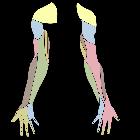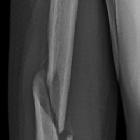Nervus radialis


The radial nerve is one of five main branches of the brachial plexus. It provides motor and sensory innervation to the arm and forearm and sensory innervation to the hand.
Summary
- origin: one of two terminal branches of the posterior cord of the brachial plexus
- course: posteromedially with the axillary vessels, behind the humerus, then anteriorly towards the elbow where it divides into superficial and deep branches
- terminal branches: posterior interosseous (deep) and superficial radial nerves
- motor: elbow, wrist and finger extension
- sensory: dorsal aspect of the thumb, index and middle fingers
Gross anatomy
Origin
The radial nerve is one of two terminal branches of the posterior cord of the brachial plexus. It receives contributions from C5-T1 nerve roots.
Course
The radial nerve lies posterior to the axillary artery in the axilla and enters the posterior compartment of the arm under teres major muscle.
In the posterior compartment of the arm, it winds its way around the spiral groove of the humerus, accompanying profunda brachii artery. It pierces the lateral intermuscular septum at the midpoint of the humerus to enter the anterior compartment of the arm. It lies deep to the upper brachialis and then brachioradialis. It passes to the forearm by coursing anterior to the lateral epicondyle at the level of the elbow joint. It enters the cubital fossa, where it divides into superficial and deep branches.
The superficial branch courses towards the wrist lateral to the radial artery (which runs with it one third of the way down the forearm) and enters the hand, dividing into the dorsal digital cutaneous branches. It lies from above downwards on supinator, pronator teres and flexor digitorum superficialis and is posterior to brachioradialis. It eventually emerges from under the tendon of brachioradialis proximal to the radial styloid and passes over the anatomical snuffbox.
The deep branch gives off the posterior interosseous nerve, which passes between the heads of the supinator muscle to enter the posterior compartment of the forearm, runs in the plane between the deep and superficial muscles of the compartment, and terminates at the level of the wrist joint.
Branches and supply
- muscular twigs in the arm: triceps brachii, anconeus, brachioradialis, extensor carpi radialis longus muscles
- superficial branch of the radial nerve: supplies cutaneous sensation to the dorsal aspect of the hand, dorsal aspect of the first to third digits and the dorsal lateral aspect of the fourth finger (sparing the finger tips)
- deep branch of the radial nerve: direct innervation to the extensor carpi radialis brevis and supinator muscles
- continues as the posterior interosseous nerve to supply the deep extensors of the dorsal arm (extensor digitorum, extensor digiti minimi, extensor carpi ulnaris, extensor indicis, extensor pollicis longus, extensor pollicis brevis, abductor pollicis longus)
- articular twigs to the elbow and wrist joints
Variant anatomy
- instead of running between the two heads of supinator, the deep branch of the radial nerve may travel in the arcade of Frohse, which may be a site of impingement
- absence
- superficial branch may be doubled
- may supply the entire dorsum of the hand
- may supply a small branch to the lateral portion of brachialis
- may communicate with the ulnar nerve in the arm
- may accompany the axillary nerve through the quadrangular space
Related pathology
Radial nerve pathology is complex and can occur at any level (axillary, spiral groove, radial tunnel, posterior interosseous, superficial radial):
- radial tunnel syndrome
- radial nerve palsy
- radial nerve entrapment
Siehe auch:
- Sulcus radialis
- radial tunnel syndrome
- Schwannom Nervus radialis
- Verletzungen Nervus radialis
- Radial nerve block (ultrasound-guided)
und weiter:

 Assoziationen und Differentialdiagnosen zu Nervus radialis:
Assoziationen und Differentialdiagnosen zu Nervus radialis:


